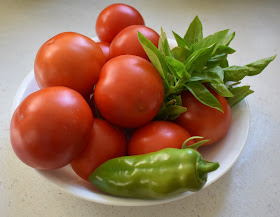This one, pictured below, was probably no more than 15 feet tall when we moved here in 1995. Now, it towers well above that and shades a good percentage of the northeast section of the backyard.
I also took the dogs on a long walk (45 minutes each; 1 1/2 hours total for me) as well as short walks just to have them go to the bathroom and see something different than the backyard.
Saw three deer on our walk which was a highlight of the week. The dogs were super excited to see the deer leaping across the road and into a field. Their white flag tails gave away where they were headed.
I always like looking at the clouds too. So many different formations, colors, and textures depending on the weather and time of day.
I was practicing some calling to the dogs to see if they would come to me.
Aspen was happy to play that game.
She put a lot of effort into running as fast as she could to me.
She's such a great dog. All the dogs are so good. They get along very well now - like they've been together their entire lives.
The most inspiring thing we experienced was...was not outside, but it had to do with wildlife. We went to a program at the library about reptiles and amphibians. We all learned a lot of new facts about various types of wildlife - like a corn snake, soft-shelled turtle, gecko, and alligator.
We also saw a Cane Toad (pictured below) that will puff itself up to appear larger to enemies. It originally was from South America, but was introduced to different countries and continents - including Australia. Originally, it was introduced as a way to reduce insects that were damaging farmers' crops.
The Cane Toad has poison glands near its head that, when consumed, are toxic. So, with no natural predators, however, the Cane Toad multiplied. The toad then became invasive and a pest more than a help. Human intervention needed to happen to control the Cane Toad population.
We also learned about bearded dragons. It is called “bearded” because of the dragon’s ability to flare out the skin in the throat region when it is threatened or territorial.
There was a boa constrictor that we all touched.
It was very smooth and so docile.
Apparently, though, boa constrictors can take down larger animals - including deer, wild boar, and other big mammals.
The other inspiring thing are the flowers this year. Our Oriental Lilies did exceptionally well and provided a fragrant entry to and from the driveway to the home. There were a variety of pinks and whites. This one is one of the last remaining lilies of the season.
The prairie wildflowers also are doing well. Off and on during the season, the flowers have been blooming. This purple one has many flowers on it now.
The honey bees and wild bees have been visiting the flowers and blossoms. It's been nice seeing them have a variety of things to choose from for their nectar and pollen sources.
In June, I planted violets and pansies underneath the pine trees by the back door. The garden center staff said that they will last a little while in June, but by July - with all the heat - they will be gone.
There are still some flowers blooming which has been nice to see. They are so dainty and colorful; and definitely like the shade of the pine trees.
I also tried something new this year: borage. It's supposed to attract bees, so people put it in their garden. The plant gets pretty big and there are these unusual flowers on it.
There's another type of flower that I really like: Lantana. These colorful little flowers have a variety of different colors on them - pinks, oranges, and yellows.
They are annuals, and add so much vivid color to a planter that I have them in. They are right outside the mudroom window, so multiple times per day (when I let the dogs outside), I get to enjoy them.
Our outdoor time made us ask (or wonder about)...why does one of our horses drool excessively during the summer, but not the other one?
Found out that the drooling is linked to red clover. According to EquiMed, "Horses grazing in pastures where clover is present face health problems depending on the type of clover, how much is present in the forage, and whether or not it is contaminated with fungus or other toxins."
EquiMed continued, "Horses grazing in pastures where clover is present face health problems depending on the type of clover, how much is present in the forage, and whether or not it is contaminated with fungus or other toxins."
It seems like this condition is linked to "the toxin slaframine in Red Clover [that is] infested with Rhizoctonia leguminicola which causes excessive salivation." It also can result from molds that grow in the sweet clover.
What is comforting to know that the red clover plant is not toxic. However, it is an annoyance for both the horse and owner because horses will slobber a tremendous amount. Slaframine poisoning is the official name for this condition. It's not life-threatening which is good.
"Basically, the slaframine stimulates the salivary glands and causes horses to drool. Although this is a nuisance, horses rarely suffer any health effects from grazing infected clover," EquiMed noted.
In the garden, we are planning/planting/harvesting....tomatoes and herbs mostly. Sophia entered dried rosemary in the county fair and received a blue ribbon; and I entered dried chives and basil from the garden. Both received blue ribbons as well.
Picked a bowl full of tomatoes from the garden this afternoon along with a pepper and some basil. This year, the tomatoes have done the best out of all the vegetables (mainly due to the rabbit situation).
I added nature journal pages about....nothing yet. I still need to get caught up with my July entries before adding some for August. The time just seems to be going by too quickly.
I am reading...books unrelated to nature and wildlife at this moment. Most of the time reading is spent on reviewing curriculum and writing syllabi for the upcoming homeschooling year.
That being said, I'm excited about this year's curriculum that Olivia will be using for history. It has a nature journaling component to it as well as poetry that focuses on nature poems.
So, I'll be reading more about nature and wildlife next month once we start working on that curriculum.
I am dreaming about…wanting to see the last states that I haven't explored yet in the United States; and taking the girls to states they haven't visited yet.
Ohio and Georgia are the only states left that I haven't visited.
It would be nice to see some state and national parks in the states we visit. Some of the best memories from trips I've taken in recent years are from visiting parks and sanctuaries.
A photo I would like to share...this is thistle that is growing on our farm. It is a nightmare in terms of trying to get rid of this stuff. Although the flower is pretty - such a beautiful shade of purple - and the bees and goldfinches love it, it plays havoc with the horses' manes and forelocks.
Today, as I was trying to smash the plants down (which are about 4 1/2 feet tall at this point), my hair would get stuck in the burrs. It happens so quickly and then you're tangled.
With the horses, the burrs get tangled in their manes and forelocks. They just pull them out of the plant when they move. They wait until we remove them since they can't do that on their own.
In my case, I could use my fingers and remove my hair from the burrs. It took a while. The burrs had a very firm grasp on my hair.
I remember my dad telling me to get rid of thistle and burdock. They cause more problems than what they are worth. It's time to take his advice and put it into action.
Thank you to Barb the Outdoor Hour Challenge for the idea of doing an Outdoor Mom's Journal.




















So much in this post! Enjoyed t all.
ReplyDeleteI remember seeing a documentary about the cane toads in Australia...and also they had a plague of mice!
Great post...if I wasn't so tired I would comment more--LOL! ;)
Dogs, and flowers, and some wildlife - nice companions for the outdoor experiece!
ReplyDelete